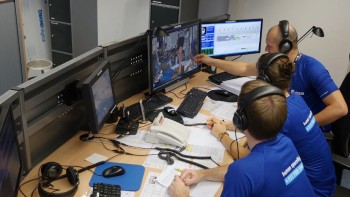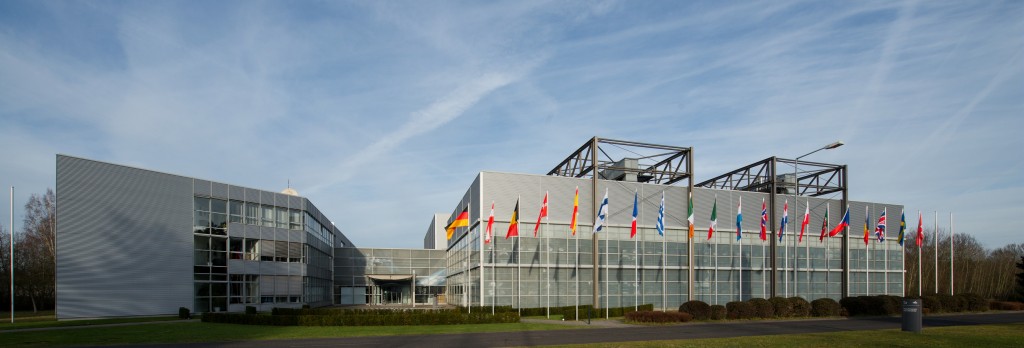With the London Marathon on Sunday we continue to introduce the hard-working teams that support Tim during his time in space. Based at the European Astronaut Centre in Cologne, Germany, a number of people assure that Tim stays healthy. His attempt to run a marathon on the International Space Station’s treadmill means that his fitness programme and diet has been adapted to ensure he will return to Earth in full health – and complete the 42 km run. We asked the teams some questions to introduce themselves:
What is your team name?
We are the Space Medicine Office Exercise Team – or ET
What do you do?
We plan and implement the daily exercise programme of ESA astronauts on the International Space Station to minimise microgravity-induced reductions of bone and muscle strength, and maintain their overall physical performance. This includes pre-flight preparation and training sessions with astronauts as well as post-flight rehabilitation to support the recovery process after a long spaceflight. This comes with a lot of international collaboration with our international partners and exercise counterparts the other space agencies, and we are also involved in many projects looking at future applications of exercise and health support in human spaceflight.
What does your work typical day look like?
There is no typical day, since it varies with the tasks and activity status. But as an example, during a Space Station mission with an ESA astronaut, we typically receive weekly notifications of exercise data that have been downlinked and are available on a server. We download the data, insert them into our system, analyse them and provide the exercise prescriptions for the next week. On a monthly basis we talk to our crew member about current exercise issues during the PEC – Private Exercise Conference – on console, and we even coach astronauts through strength exercises during real-time ARED sessions via a private audio and video connection with the International Space Station.
How is working for Principia/ESA?
Although Principia is now our ninth ESA long-duration mission, no mission is alike aside from the general operational routine. Each astronaut brings individual challenges and solutions to the system, and each time this work is very rewarding. Tim is a great person to work with. We are now facing the challenge of performing a full marathon in space, synchronised with the real London Marathon via an internet-based app – a cool project.
Running in microgravity is not as easy as running on Earth: the astronaut needs to be tethered to the treadmill through a harness that puts most of the load on shoulders and hips. The astronauts float freely in the Space Station so a specially-designed loading system is required to pull the runners’ body onto the treadmill. A harness distributes the pulling force over the upper body, so Tim’s shoulders need to be prepared to withstand the induced force for the duration of the entire race. The treadmill itself is not even hard mounted to the hull. Enduring this for around four hours is a much tougher challenge than any other marathon runner experiences on the ground.
How have you adapted to Tim’s marathon?
In anticipation of a much longer running protocol than usual on the International Space Station (around four hours instead of 30-40 minutes), we gradually increased duration and intensity of his running protocols. However, scheduling long runs of more than one hour per session is a logistical challenge in itself as other astronauts are also required to use the hardware. We had to limit the number of training sessions over one hour, and they were mainly planned on the weekend when the Space Station crew schedules are less fixed. We hope that Tim will still be able to complete the run despite its preparation being less convenient than on earth. He can take breaks if needed, but we know from earlier experience by NASA astronaut Sunita Williams that running a marathon in space is possible, and Tim is an excellent runner. Completing the full marathon distance will likely take longer than it would on Earth of course.
What is the best part of your job?
The best part is that it has multiple parts. There is never a really boring routine and repetitive actions, although we grew considerable experience and proficiency over the past years. There are always new challenges and new tasks to face and solutions to find. It is a nice mix of practical and theoretical work, a mix between desk work, meetins, gym and workshops coupled with interacting with universities and external institutions. And it is very relevant to all of us: developing strategies for physical performance and health support on Earth and in space, in particular with respect to technological and physical challenges associated with spaceflight is of interest to all “earthlings”.
Anything else?
Maybe an interesting fact is that one of our ESA astronauts pointed out once: compared to all other International Space Station partner space agencies, our European Astronaut Centre gym is the only one with direct access to nature (through a huge window). 🙂



Discussion: one comment
you need to involve the medical profession in my project. speak to woerner, contactesa@esa.int and ecsl.